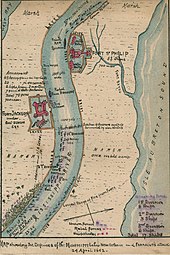Manassas (ship)
|
||||||||||||||||
|
||||||||||||||||
|
||||||||||||||||
|
||||||||||||||||
The Manassas was an ironclad of the Confederate States Navy (CSN) and, as far as is known, the first ironclad to be constructed on the American continent. Due to its unusual " turtle hump" armor, it was visually one of the most unusual ships of the 19th century. She was referred to by officers of the United States Navy as "the queer gentleman" or also as the infernal machine .
Building history
The screw steamer Enoch Train was built as an icebreaker and was apparently used until the outbreak of the Civil War in Massachusetts . It was then picked up by the Confederate privateer Ivy (later classified as a gunboat ). A private citizen, Captain John A. Stevenson, planned her assignment as a southern captain and apparently had the ship rebuilt in Algiers , Louisiana , at his own expense .
During the renovation, the superstructures and masts of the Enoch Train were completely removed and an armored deck in the shape of a turtle hump was assembled from railroad tracks . The ship was equipped with an immovable gun that could only fire in the direction of travel. The tank completely covered the parts of the ship lying above the waterline . Due to the curved shape of the tank, any projectiles ricocheted off the hull. The armor lay on a thick layer of oak. In addition, the vehicle was equipped with a ram . When loaded, the upper deck, apart from the chimney , was only 6.5 feet above the water level. It is unclear whether the ship had one or two chimneys, as contemporary images show one or the other variant. The ironclad was named after the First Battle of Manassas .
commitment
The Manassas was apparently put into service on September 12, 1861 as a private privateer, but immediately afterwards was requisitioned by the CSN for use on the lower Mississippi . Lieutenant AF Warley became the commandant .
On October 12, 1861, she took part in an attack on the federated blockade forces at the Head of Passes in the Mississippi Delta . They rammed the Sloop Richmond , although the ramming by a located between the vessels coals easier was alleviated. Even so, the shaking of the Manassas was so strong that they lost the iron bow and one (or the) chimney. In addition, one of their two steam engines was torn from the foundation, so that the ship was temporarily unable to maneuver. However, she managed to retreat, with the bullets fired by the Richmond and Preble ricocheting off her tank. Two months later, the Manassas was bought directly by the Confederate government; possibly only now an official commissioning in the CSN took place.
On April 24, 1862, the Manassas took part in the battle for forts Jackson and St. Philip when Commodore David Glasgow Farragut broke through to New Orleans with his squadron . While trying to ram the Pensacola , the ironclad was caught in the fire of the entire squadron, but remained undamaged. She managed to damage the Mississippi slightly by ramming it, but it remained maneuverable. Then she rammed the Brooklyn , which was badly damaged, but also remained maneuverable.
In pursuit of the Union fleet, the Mississippi turned and tried in turn to ram the Manassas . During an evasive maneuver, the ironclad hit a shoal and had to be abandoned by its crew. Under heavy fire from the Mississippi , the Manassas caught fire, slid off the shallows and floated down the river. Here she met a flotilla of mortar boats under Commander David Dixon Porter . Porter tried to recover the drifting wreck as a technical curiosity , but the Manassas exploded and sank as a total loss to position 29 ° 20 ′ 38.3 ″ N , 89 ° 24 ′ 47.8 ″ W .
The wreck
As far as is known, the wreck was magnetically located near the sinking site in November 1981 , but is said to be under a layer of mud up to nine feet thick. The site belongs to the community of Boothville in Plaquemines Parish . As far as is known, it has never been investigated until the present (as of 2017).
literature
- Raimondo Luraghi: A history of the Confederate navy , Annapolis, MD (Naval Institute Press) 1996. ISBN 1-55750-527-6 .
- Jack Greene / Alessandro Massignani: Ironclads at war. The origin and development of the armored warship, 1854-1891 , Conshohocken, PA (Combined Publishing) 1998. ISBN 0-938289-58-6 .
- Dirk Nottelmann : CSS MANASSAS 1861. The reconstruction of an unusual ship , in: Das Logbuch , year 1996, issue 2, pp. 71–77.
- Angus Konstam: Confederate Ironclad, 1861-65 , Oxford (Osprey Military) 2001. ISBN 1-84176-307-1 .





